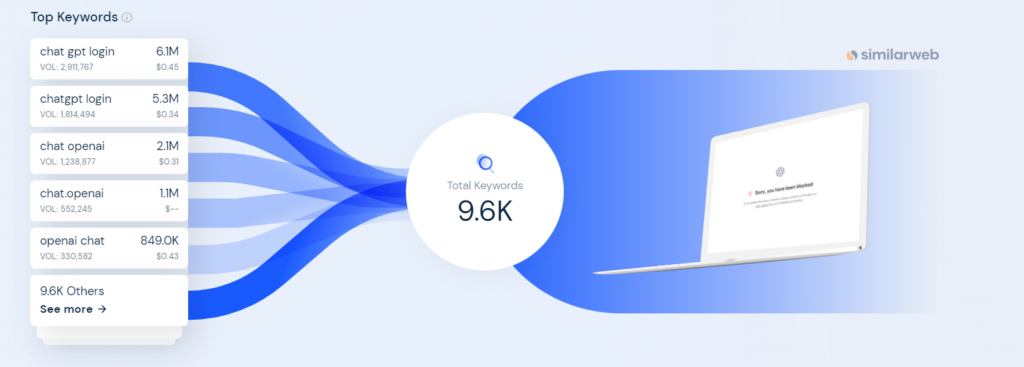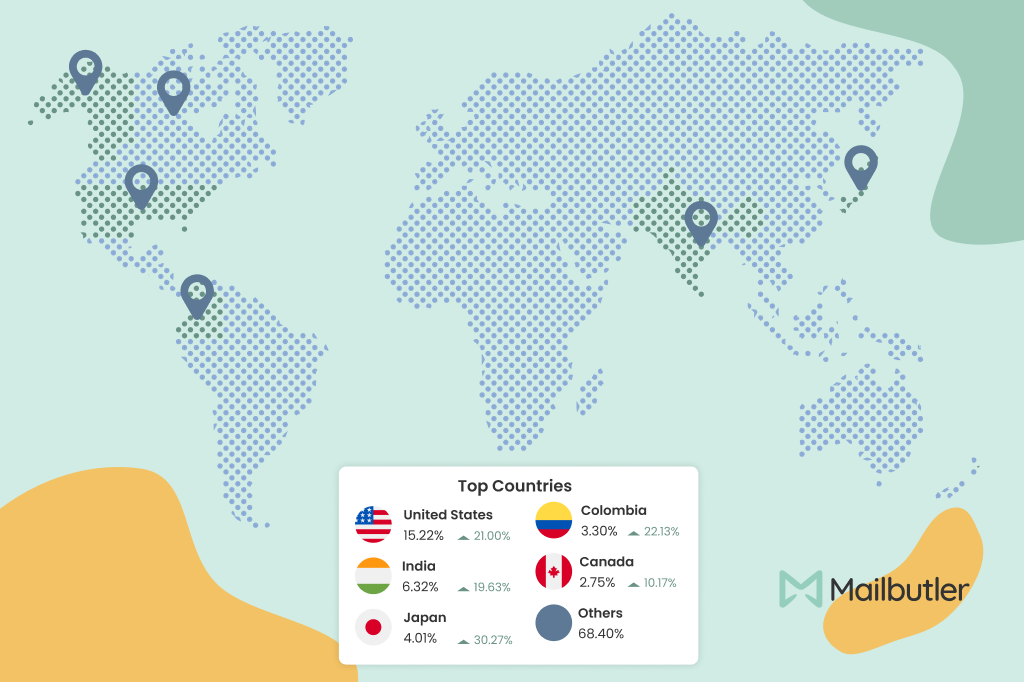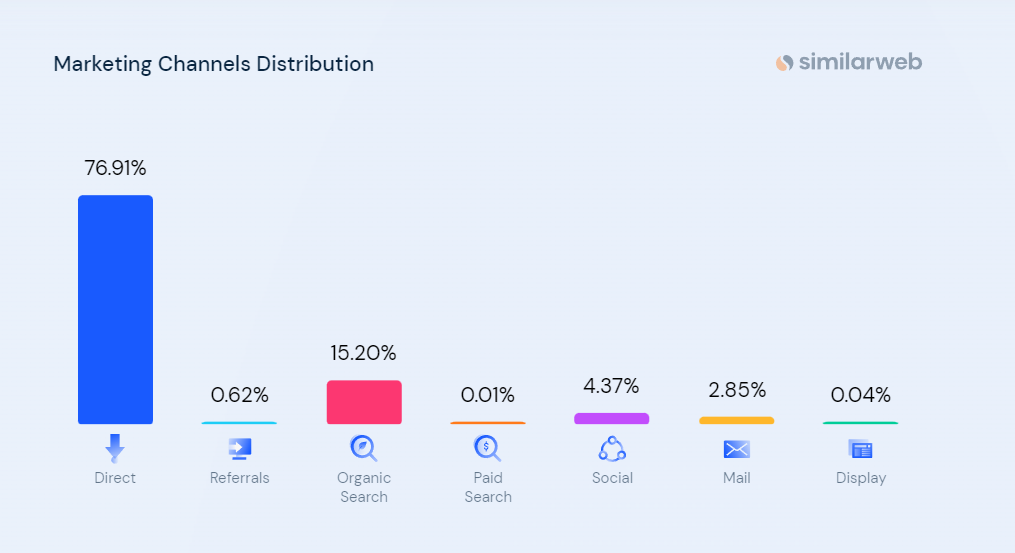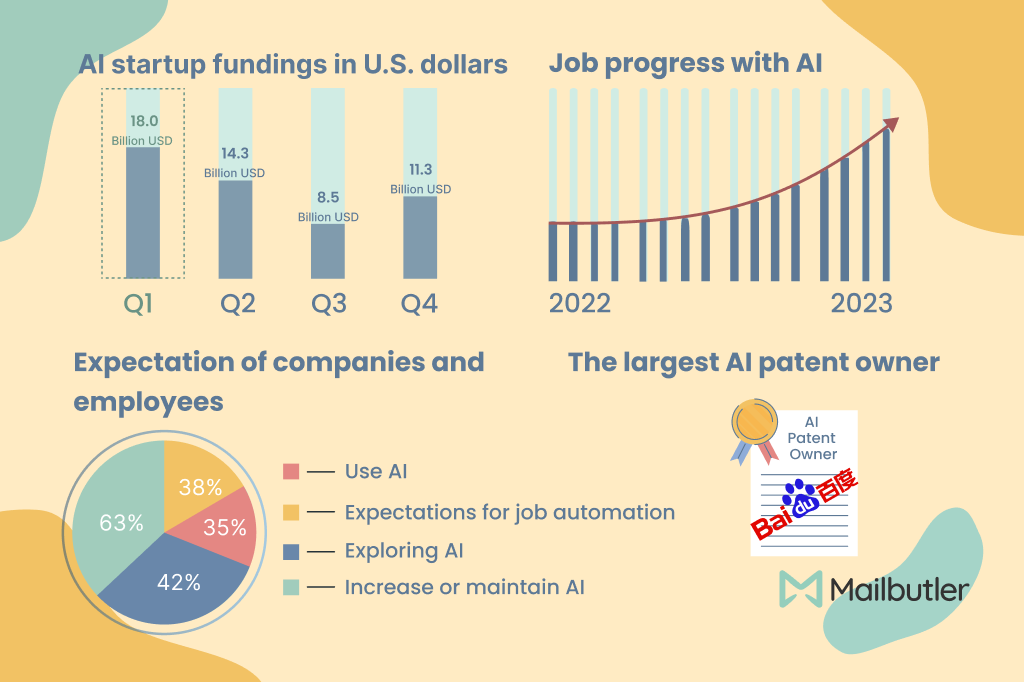Artificial Intelligence
AI Email Writer – Mailbutler’s Smart Assistant
Explore Mailbutler's AI email writer with our simple guide. Discover efficient email management with this premium AI email generator.
Check out Mailbutler's full list of up-to-date AI and ChatGPT statistics for April 2024.
James has seven years' experience as a Content Marketer, bylines on Left Foot Forward, Submittable, and INOMICS, and a Master's in History. In his free time he likes to read, play guitar, and write for his personal blog.
Artificial intelligence: sounds complex, right? But there's one AI, ChatGPT by OpenAI, that's as easy to use as talking to a friend. Let's check these up-to-date ChatGPT statistics and AI in general and see just how much this AI is changing the game.

ChatGPT keywords by traffic share - source Semrush
The following keywords generate a significant amount of US traffic for ChatGPT:
These keyword search volumes suggest that a large number of people in the USA are interested in and searching for information related to ChatGPT and other OpenAI projects.
This screenshot shows the global top keywords for ChatGPT:

Source: Similarweb.com
The majority of ChatGPT users are found in the US, making up 13.07% of the total user base.
India follows in second place but with significantly fewer users, accounting for only 8.47% of the total.
The combined user base from the top five countries - the US, India, Japan, Colombia, and Brasil - comprises roughly one-third of all ChatGPT users.
Here's a detailed overview of the user distribution by country:

Regional distribution of ChatGPT users
The dominant channel for ChatGPT visits is direct, accounting for over 7 out of 10 visits (76.91%).
Organic search channels rank second, contributing 15.20% of the overall traffic.
Here's a detailed distribution of ChatGPT marketing channels:

Web traffic for ChatGPT
In the social media world, YouTube leads as the top source of traffic, bringing in nearly 3 out of 5 visits (56.71%).
Here's how other social media platforms fare:

Traffic channels for ChatGPT
ChatGPT | Bing Chat | Google Bard | |
| Type of Platform | Conversational AI Tool | AI-Powered Conversational Internet Search | AI-Powered Conversational Internet Search |
| Powered By | OpenAI’s GPT-4 Language Model | Microsoft AI | Google’s LaMDA |
| Data Source | 570 GB of textual data from websites, books, and other sources. | Websites on Bing Search Index, user input, knowledge bases | Websites & sources on Google Search Index |
| Knowledge base | Limited up to 2021 (but now can access the internet) | Aware of all present & past events | Aware of all present & past events |
| Availability | Generally available (free + paid) | Available to all | Currently available in the US, UK, and 180 more countries |
| Usage | Limited per hour | Unlimited | Unlimited |
GPT-4, the new version of OpenAI's language AI, is a big step up from the old version, GPT-3.5. It's much better at understanding and using language, figuring out the context, and handling a lot more information. It's good at understanding different ways of speaking and reacting to emotions. It can answer tough questions using info from many sources. It's more creative and makes more sense when it's making up stories. It's also better at solving hard problems in math and science and can write and fix computer code more efficiently.
Unlike GPT-3.5, which only deals with text, GPT-4 can also understand and talk about pictures and graphics. It's less likely to say things that are biased or inappropriate. In the future, it could get better at understanding context and who's talking to it, work with other software, remember past chats, and be less likely to believe false info. GPT-4 could be useful in lots of areas, like writing, teaching, and customer service, which makes it a very important tool for our everyday lives.
AI helping with emails can definitely make things simpler for us. But, some people might feel a bit nervous about this advanced tech. In 2023, about 347.3 billion emails were sent every day, and this number will probably keep growing each year. That leaves space for AI tools to help us handle our emails better and quickly find the important ones.
ChatGPT can be used in numerous ways for email communication:
Drafting emails: ChatGPT can help draft emails, letters, and other forms of written communication. This includes formal business correspondence, informal communication, and everything in between.
Reply suggestions: Based on the context of an incoming email, ChatGPT can suggest potential replies, which can be particularly helpful for managing a large volume of emails or for providing initial drafts to be edited.
Content ideas: If you're looking to send a marketing or newsletter email but aren't sure what to write about, ChatGPT can provide content ideas based on given keywords or topics.
Personalized emails: ChatGPT can generate personalized emails for different recipients based on user-provided information.
Mailbutler conducted an anonymous survey with over 200 participants. This is what we found out:

Mailbutler's survey about AI
As we can see based on these statistics on ChatGPT the road ahead looks quite bright and thrilling. As we get better at teaching computers to understand and use language, tools like ChatGPT will keep getting smarter. They're about to shake up how we work and could change many jobs. Some folks even think that, in a little while, ChatGPT and its kin could be as smart as humans, or nearly as smart.
Here are some pros and cons of advanced AI models like ChatGPT:
Pros
Cons
ChatGPT assistant for Microsoft Outlook

Key AI statistics by Mailbutler
AI technology has been increasingly adopted by businesses in various sectors. According to a TechJury article, 35% of companies are already using AI, and another 42% are exploring its implementation. IT analyst firm, Info-Tech Research Group, reports that 44% of private sector companies plan to invest in AI systems in 2023. Meanwhile, 91.5% of leading businesses invest in AI on an ongoing basis. As for AI's impact on customer satisfaction, Gartner expects it to grow by 25% by 2023 in organizations that use AI.
The AI market is seeing significant growth. As of 2022, Precedence Research reported a global market size of $119.78 billion. This is projected to skyrocket to $1,597.1 billion by 2030, with a compound annual growth rate (CAGR) of 38.1% from 2022 to 2030. The AI market share in the United States alone is anticipated to be valued $$420.465 billion by 2025.
AI usage is widespread and varied. In terms of voice assistants, 97% of mobile users use AI-powered tools, and more than 4 billion devices currently operate on these systems. A whopping 63% of companies surveyed plan to increase or maintain AI and machine learning spending in 2023. Moreover, AI technology is expected to create 12 million more jobs than it is expected to replace, and 97 million specialists are anticipated to be needed in the AI industry by 2025.
AI is transforming the way businesses operate. It's used to automate processes, enhance customer service and personalization, increase output, and analyze data, all in the pursuit of gaining a competitive advantage. Technology is also proving to be a key player in the marketing and retail sectors. For instance, AI spending in the retail industry is projected to reach $20.05 billion by 2026. Additionally, 48% of marketing leaders say AI has significantly changed how customers interact with their businesses.
AI's growth and the rise of machine learning have sparked concern over job security. Semrush reveals that 38% of employees expect their jobs to be automated by 2023 and 13% foresee AI eliminating positions entirely in their industry. However, there is a silver lining. AI technology is projected to create more jobs than it replaces, with an expected 12 million more jobs created and a high demand for 97 million specialists in the AI industry by 2025.
Microsoft’s Copilot vs. Mailbutler’s Smart Assistant
Best AI Email Assistants in 2024
Future of email communication with AI
https://www.statista.com/topics/3104/artificial-intelligence-ai-worldwide/
https://www.statista.com/statistics/1365145/artificial-intelligence-market-size/
https://www.similarweb.com/blog/insights/ai-news/chatgpt-growth-flattens/
https://www.semianalysis.com/p/the-inference-cost-of-search-disruption/
https://www.similarweb.com/website/chat.openai.com/#traffic-sources
https://www.similarweb.com/website/openai.com/
https://www.mordorintelligence.com/industry-reports/ai-market-in-social-media




